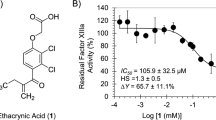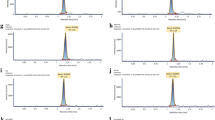Abstract
Purpose. To determine the degradation rates and pathways of GS-522, a potent oligodeoxynucleotide (GGTTGGTGTGGTTGG) inhibitor of thrombin, in serum and plasma.
Methods. A stability-indicating, anion-exchange HPLC method was developed and used to determine concentrations of GS-522 and metabolites.
Results. In monkey plasma at 2 µM or below, the degradation of GS-522 can be fit to a first-order exponential with a kp obs ~ 0.01 min−1. At 3 µM and above the degradation process deviates from a monoexponential decay profile. An initial fast degradation process is followed by a slower phase with an observed rate constant equal to that observed at 2 µM and below. In monkey serum, the KMand Vmaxare 8.4 µM and 0.87 µM min−1, respectively.
Conclusions. The kinetics are consistent with an equilibrium binding of GS-522 to prothrombin in plasma (Kd = 50 nM) which saturates at GS-522 concentrations >2 µM. Compared to a scrambled sequence (GGTGGTGGTTGTGGT), with no defined tertiary structure, GS-522 is 4-fold more stable in serum. The metabolic profile in plasma is consistent with a 3′-exonuclease catalyzed hydrolysis of GS-522.
Similar content being viewed by others
REFERENCES
J. F. Milligan, M. D. Matteucci, and J. C. Martin. Current concepts in antisense drug design. J. Med. Chem. 36:1923–1937 (1993).
S. L. Young, S. H. Krawczyk, M. D. Matteucci, and J. J. Toole. Triple helix formation inhibits transcription elongation in vitro. Proc. Natl. Acad. Sci. USA 88:10023–10026 (1991).
L. C. Bock, L. C. Griffin, J. A. Latham, E. H. Vermaas, and J. J. Toole. Selection of single-stranded DNA melocules that bind and inhibit human thrombin. Nature 355:564–566 (1992).
L. C. Griffin, G. F. Tidmarsh, L. C. Bock, J. J. Toole, and L. K. Leung. In vivo anticoagulant properties of a novel nucleotide-based thrombin inhibitor and demonstration of regional anticoagulation in extracorporeal circuits. Blood 81:3271–3276 (1993).
K. Y. Wang, S. McCurdy, R. G. Shea, S. Swaminathan, and P. H. Bolton. A DNA aptamer which binds to and inhibits thrombin exhibits a new structural motif for DNA. Biochemistry 32:1899–1904 (1993).
R. F. Macaya, P. Schultze, F. W. Smith, J. A. Roe, and J. Feigon. Thrombin-binding DNA aptamer forms a unimolecular quadruplex structure in solution. Proc. Natl. Acad. Sci. USA 90:3745–3749 (1993).
L. R. Paborsky, S. N. McCurdy, L. C. Griffin, J. J. Toole, and L. K. Leung. The single-stranded DNA aptamer-binding site of human thrombin. J. Biol. Chem. 268:20808–20811 (1993).
E. W. Salzman. Low-Molecular-Weight Heparin and Other New Antithrombotic Drugs. N. Engl. J. Med. 326:1017–1019 (1992).
L. G. Davis, M. D. Dibner, and J. F. Battey. Basic methods in molecular biology. Elsevier, Amsterdam, 44–46 (1986).
PCNONLIN® Version 4.2, Software for the Statistical Analysis of Nonlinear Models on Micros, Statistical Consultants, Inc., Lexington, KY.
H. Akaike. A Bayesian analysis of the minimum AIC procedure. Ann Inst. Statist. Math. 30:9–14 (1978).
W. Haupt and A. Pingoud. Comparison of several high-performance liquid chromatography techniques for the separation of oligodeoxynucleotides according to their chain lengths. J. Chromatogr. 260:419–427 (1983).
J. M. Stephens, L.-C. Yuan, and W. A. Lee. Extinction Coefficient Determination by Quantitative Base Composition Analysis of GS-522, a Novel Oligodeoxynucleotide Inhibitor of Thrombin. Abstract No. 13th International Symposium on the HPLC Analysis of Proteins, Peptides, and Polynucleotides, San Francisco, CA, December 1993.
J. H. Jandl. Blood, Textbook of Hematology. Little, Brown and Co., Boston, 1987.
Q. Wu, M. Tsiang, and J. E. Sadler. Localization of the single-stranded DNA binding site in the thrombin anion-binding exosite. J. Biol. Chem. 267:24408–24412 (1992).
P. J. Braun and K. M. Szewczyk. Relationship between total prothrombin, native prothrombin and the International Normalized Ratio (INR). Thrombosis and Haemostasis 68:160–164 (1992).
N. B. Kurnick. Desoxyribonuclease activity of sera of man and some other species. Arch Biochem Biophys. 43:97–107 (1953).
D. Riesner, A. Pingoud, D. Boehme, F. Peters, and G. Maas. Distinct Steps in the Specific Binding of tRNA to Aminoacyl-tRNA Synthetase. Eur. J. Biochem. 68:71–80 (1976).
R. F. Macaya, P. Shultze, F. W. Smith, J. A. Roe, and J. Feigon. Thrombin-binding DNA aptamer forms a unimolecular quadruplex structure in solution. Proc. Nat'l. Acad. Sci. USA. 90:3745–3749 (1993).
C. A. Stein, C. Subasinghe, K. Shinozuka, and J. Cohen. Physiochemical properties of phosphorothioate oligodeoxynucleotides. Nucleic Acid Res. 16:3209–3221 (1988).
E. Wickstrom. Oligodeoxynucleotide stability in subcellular extracts and culture media. J. Biochem. Biophys. Methds. 13:97–103 (1986).
S. Akhtar and R. L. Juliano. Stability of antisense DNA oligodeoxynucleotide analogs in cellular extracts and sera. Life Sciences 49:1793–1801 (1991).
J.-P. Shaw, K. Kent, J. Bird, J. Fishback, and B. Froehler. Modified deoxyoligodeoxynucleotides stable to exonuclease degradation in serum. Nuc. Acids Res. 19:747–750 (1991).
P. C. de Smidt, T. L. Doan, S. de Falco, and T. J. C. van Berkel. Association of antisense oligodeoxynucleotides with lipoproteins prolongs the plasma half-life and modifies the tissue distribution. Nuc. Acids Res. 19:4695–4700 (1991).
P. S. Eder, R. J. DeVine, J. M. Dagle and J. A. Walder. Substrate specificity and kinetics of degradation of antisense oligodeoxynucleotides by a 3′-exonuclease in plasma. Antisense Res. and Dev. 1:141–151 (1991).
Rights and permissions
About this article
Cite this article
Shaw, JP., Fishback, J.A., Cundy, K.C. et al. A Novel Oligodeoxynucleotide Inhibitor of Thrombin. I. In VitroMetabolic Stability in Plasma and Serum. Pharm Res 12, 1937–1942 (1995). https://doi.org/10.1023/A:1016243923195
Issue Date:
DOI: https://doi.org/10.1023/A:1016243923195




